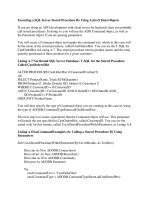Tài liệu Create a WAN Using SDSL Modems pptx
Bạn đang xem bản rút gọn của tài liệu. Xem và tải ngay bản đầy đủ của tài liệu tại đây (537.3 KB, 3 trang )
As seen in the February/March 2002 issue of
LAW OFFICE COMPUTING
www.lawofficecomputing.com
O
rganizations with seve ral offices
located in the same city usually
want to link them into a single secure
n e t work. Although, not applicable for all
situations, if your organizations are with-
in the same city, you might be able to
set up a “campus” type system using sin-
gle-line Digital Subscriber Line (SDSL )
modems connected by a single pair of
phone wires.
This pair of wires, re f e r red to by
various names by different phone com-
panies, is most often called a “dry pair.”
This is an unconditioned telephone wire
c i rcuit from one location to another
without telephone equipment connect-
ed to it. These circuits are often much
less expensive than other alternative s
offered by the phone company, and can
a c h i e ve synchronous speeds of 2
Megabits per second
(Mbps) in each direction within dis-
tances not exceeding two miles.
Connection speed begins to drop after
distances exceeding two miles, but
respectable speeds can be achieved at
distances of four to five miles.
SDSL modems are bridging devices
used to connect to remote segments of
your Local Area Network (LAN). These
segments can be in different buildings
or separated by many floors in a build-
ing. The connecting pair of wires can
be user-owned as in a campus LAN or
p rovided by the phone company using
its wiring circuits. Traffic is synchro n o u s ,
meaning the same speed in both dire c-
tions, which is an important considera-
tion if you are sharing databases or files
or want to backup data over the link.
C o n f i g u ration from point to point
looks like the following:
Office A Hub <——> SDSL
modem <——> dry pair
wiring <——> SDSL modem <——>
Office B Hub
To give an example of their use and
how easy or hard it is to connect offices
with this setup, we will take you thro u g h
an actual installation we performed.
The objective was to link five
offices, each with its own LAN into a
single network where various facilities
a re located any w h e re from 4,000 to
13,000 feet line distance. (Line distance
is the length of the wire between the
t wo end points and will have to go
t h rough a telephone wire center or
switch office unless you are running
your own direct wire.)
The Wide Area Network (WA N )
was constructed to share netwo r k
re s o u rces and to minimize the number
of Internet Service Provider (ISP )
accounts and the need to secure each
access point (including emergency ser-
vice providers), which is best done using
h a rd - w i red land line communications
using a single broadband access point
that is shared by all offices and secured
with a firewall and antivirus system. We
looked at seve ral options, including a
virtual private network (VPN) and wire-
less networking, before deciding to use
SDSL modem bridging.
Although 80 2 .11b wireless net-
working was feasible and could provide
11 Mbps basic Ethernet performance,
80 2 .11b is expensive, with pre l i m i n a r y
Create a WAN Using
SDSL Modems
These bridging devices can connect to remote
segments of your LAN.
By Joseph L. Kashi and Thomas Boedeker
Bridging the Gap: The 300S modem was plugged in at each end point and connected phone
cords to wall jacks on each end for this installation.
As seen in the February/March 2002 issue of
LAW OFFICE COMPUTING
www.lawofficecomputing.com
ments than using routers. Some ro u t e r s
offer encryption and can be used ove r
a dry pair link. It’s also possible to use
encryption techniques in a bridging
setup such as the one that we described
h e re, but an extra level of hard wa re
encryption complicates the installation
and was not a significant concern.
When the remote segments we re
added, our network branches all came
together as a single network. The SDSL
modems are tra n s p a rent to various net-
works and protocols. The ability to con-
nect to servers and other re s o u rces is
simply based on the network opera t i n g
system softwa re clients and pro t o c o l s
that need to be installed on your re s p e c-
tive servers and workstations regardless
of how the workstations physically con-
nect to the network file servers.
All of the links under 13,000 feet
line length operate at near 2 Mbps.
N e t work packet collisions cause some
reduction when multiple computers are
trying to use the link simultaneously,
but with small remote networks of four
We installed four dry pairs in the main
office, one from each of the four remote
locations, and then had the phone com-
p a ny install four regular phone jacks in
our central office, one for each end of
e very dry pair link. Then, we simply
plugged in a 300S modem at each end
point and connected the phone cord s
to the wall jacks on each end. Wi t h i n
about 30 seconds, the modem indica-
tor lights showed good circuits. We then
connected the SDSL modem to our net-
work using Ethernet cables.
Initially, we had some internal net-
work problems until we determined that
we needed to use an uplink port on our
hub or switch or use a cro s s over cable if
connecting the modems to a standard
Ethernet port. Once the modems we re
p roperly connected to our main net-
work, individual segments we re able to
see each other. No other configura t i o n
was re q u i red. Although you give up
some flexibility, security and contro l ,
simple WAN bridges are an easier
method of connecting network seg-
estimates at about $25,000, and it’s
also potentially less secure. VPN wa s
also possible, but in our local market,
a vailable VP N options we re not syn-
c h ronous with an $8,000 estimated
setup charge. VPN also had a re c u r r i n g
monthly fee of more than $700 per
month for a mere 328 Kbps (kilobits
per second) bandwidth. VPN also left no
option for connecting to another office
location located at a line distance of
24,000 feet because our local provider
planned to use an asymmetric Digital
Subscriber Line (ADSL), which could
not reach that far.
Although our local telephone com-
p a ny doesn’t actively market the dry
pair SDS L service, we we re able to
obtain dry pair connections for a
monthly rate of only $53 for each end-
point to endpoint link, for a total re c u r-
ring cost of about $210 to $265 for all
f i ve offices. This lower monthly cost
caused us to look closely at the
SDSL/dry pair option.
Initially, our re s e a rch indicated we
could achieve ave rage line speeds in
excess of 1 Mbps over most of our net-
work, with published data indicating
that speed dropped dramatically as line
distances increased. Based on our actu-
al field results, though, we can only
assume the published performance esti-
mates are very cautious and intended to
c over a wide variety of line quality and
o p e rating conditions because we have
consistently obtained better thro u g h p u t
for a given line distance than the ve n-
dors’ published estimates.
We installed an ADC Megabit
Modem 300S (www.adc.com) with
switch selectable speed options of up to
2 Mbps, partly because we knew some-
one who already had good experience
with this product. The 300S has an RJ -
45 port to connect to the network and
an RJ-11 port to connect to the dry pair
using a standard phone to wall cord. It
uses an external power supply and is
priced at around $400.
S e ve ral other SDSL modem models
a re available, including the NetTo N e t
SNE 2000-S, the MuLogic DSL - 2048
and the Netopia R7200. Howe ve r ,
some models are limited to 1.54 Mbps.
Some other models also offer differe n t
connector options, so we suggest yo u
check carefully to be sure you have the
correct parts and connections on hand.
Our plan to connect five separa t e
locations required us to choose our cen-
t ral office, where the main servers are
located, as the WAN’s common point.
Benefits and Downsides of SDSL
The benefits we achieved using dry pair SDSL WAN were:
1. Simple setup and maintenance.
2. Synchronous connections at 2 Mbps speeds, which is faster than most
common VPN options.
3. Simplified data backup from remote segments to a central system.
4. Easy sharing of a single Internet access point.
5. Robust firewall at a single public access point with reduced network
management costs.
6. Intranet entirely within the local network, with no need to access the
public Internet.
7. Improved administration of remote computers.
8. All LAN segments can be accessed from anywhere in the system as if
they were in the same segment, although it’s slower than Ethernet.
Dry pair SDSL has some disadvantages compared to other approaches,
although these disadvantages were not critical in our installation:
1. Reduced security between the various network segments because all
segments are accessible from anywhere in the system.
2. Conflicts can arise from multiple DHCP servers if several are active on
various LAN segments.
3. If the DHCP server is down (due to a power outage), it’s possible that
remote computers can lose their current address assignment, which
causes difficulties using single-point Internet access or some database
programs that require a current IP address for the workstation.
4. Bridged SDSL is limited to 255 total computers or devices using an IP
address unless we want to choose different firewall and antivirus securi-
ty devices. This is really a limit of those devices because the SDSL bridge
can recognize 8,192 network devices. Although if you need that many
network addresses, you probably need a more robust solution anyway.
5. Traffic going out over the wiring is not encrypted by the SDSL modems.
As seen in the February/March 2002 issue of
LAW OFFICE COMPUTING
www.lawofficecomputing.com
to six computers we found no significant
reduction in speed.
As we extended to three and a half
miles we saw throughput speed drop to
about 1.5 Mbps, still T-1 speed at a
small fraction of the cost. These re s u l t s
e n c o u rage us to consider a longer link
of five miles. Although that longer link
has not been installed and tested, we
h a ve read about similar SDSL bridges
achieving T-1 speeds over distances of
four to five miles, but these longer dis-
tances work better if the copper wire is
the heavier 24 AWG rather than the
26-gauge wire that is common in older
areas.
S e ve ral other points should be
noted. If you have been using a
Dynamic Host Configuration Pro t o c o l
( DHCP) server on each LAN segment
to assign Internet Protocol (IP) addre s s-
es, you need to shut off all but one in
o rder to avoid potential conflicts in
a d d ress assignment. And, with many
security systems, you are limited to one
range of IP addresses. This will limit yo u
to 255 devices connected to the net-
work on all segments combined.
If you have a need to connect sev-
e ral offices located within two to seve n
miles of each other, then SDSL modems
using dry pair wiring to bridge between
offices is a viable solution.
Our re s e a rch leads us to conclude
that given the price of ISP and tele-
phone company services, the cost of dry
pair wiring offers some distinct cost sav-
ing possibilities worth considering. The
simplicity is such that the connection
easily can be made without extensive
technical consultant costs. In addition, in
some areas, it might prove to be a faster,
less expensive alternative than other
types of broadband access.
A B O U T T H E A U T H O R S
THOMAS BOEDEKER is the city man-
ager of Soldotna, Alaska. He is the for-
mer borough attorney for the Kenai
Peninsula. For a break from work and
computers, Boedeker plays golf and
reads mysteries and science fiction.
Boedeker has been an active attorney
and litigator for more than two decades.
JOSEPH L. KASHI practices law in
Soldotna, Alaska. He has held various posi-
tions in the ABA’s Law Practice
Management Section. He received his bach-
elor’s and master’s degrees from the
Massachusetts Institute of Technology in
1973 and his law degree from Georgetown
University in 1976. He is admitted to prac-
tice before the Alaska Supreme Court, the
U.S. Supreme Court and the U.S. Court of
Appeals for the 9th Circuit and speaks fre-
quently on legal automation topics.









